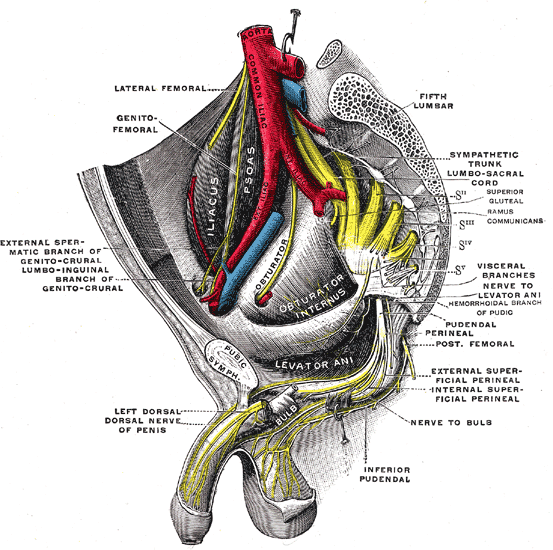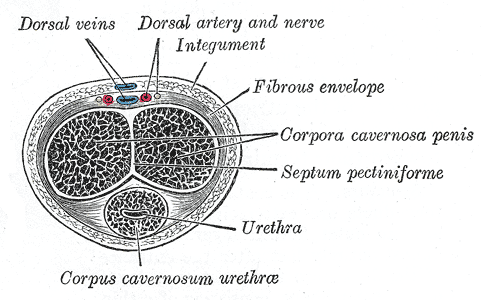[1]
Nolan MW, Marolf AJ, Ehrhart EJ, Rao S, Kraft SL, Engel S, Yoshikawa H, Golden AE, Wasserman TH, LaRue SM. Pudendal nerve and internal pudendal artery damage may contribute to radiation-induced erectile dysfunction. International journal of radiation oncology, biology, physics. 2015 Mar 15:91(4):796-806. doi: 10.1016/j.ijrobp.2014.12.025. Epub
[PubMed PMID: 25752394]
[2]
Rembetski BE, Cobine CA, Drumm BT. Laboratory practical to study the differential innervation pathways of urinary tract smooth muscle. Advances in physiology education. 2018 Jun 1:42(2):295-304. doi: 10.1152/advan.00014.2018. Epub
[PubMed PMID: 29676616]
Level 3 (low-level) evidence
[3]
Alwaal A, Breyer BN, Lue TF. Normal male sexual function: emphasis on orgasm and ejaculation. Fertility and sterility. 2015 Nov:104(5):1051-60. doi: 10.1016/j.fertnstert.2015.08.033. Epub 2015 Sep 16
[PubMed PMID: 26385403]
[4]
Gosling JA, Dixon JS, Jen PY. The distribution of noradrenergic nerves in the human lower urinary tract. A review. European urology. 1999:36 Suppl 1():23-30
[PubMed PMID: 10393469]
[6]
Giuliano F. Neurophysiology of erection and ejaculation. The journal of sexual medicine. 2011 Oct:8 Suppl 4():310-5. doi: 10.1111/j.1743-6109.2011.02450.x. Epub
[PubMed PMID: 21967393]
[7]
Alyaev YG, Akhvlediani ND. [Comparing efficacy of selective penile denervation and circumcision for primary premature ejaculation]. Urologiia (Moscow, Russia : 1999). 2016 Mar:(1 Suppl 1):60-64
[PubMed PMID: 28247749]
[8]
Manrique OJ, Adabi K, Maldonado AA, Huang TC, Martinez-Jorge J, Brassard P, Galan R, Ciudad P, Sabbagh MD. Cadaver Study of Combined Neurovascular Sensate Flaps to Create Vaginal Erogenous Sensation During Male-to-Female Genital Confirmation Surgery: The Pedicle "O" Flap. Annals of plastic surgery. 2018 Nov:81(5):571-575. doi: 10.1097/SAP.0000000000001558. Epub
[PubMed PMID: 29994881]
[9]
Jung J, Jo HW, Kwon H, Jeong NY. Clinical neuroanatomy and neurotransmitter-mediated regulation of penile erection. International neurourology journal. 2014 Jun:18(2):58-62. doi: 10.5213/inj.2014.18.2.58. Epub
[PubMed PMID: 24987557]
[10]
Chhabra A, McKenna CA, Wadhwa V, Thawait GK, Carrino JA, Lees GP, Dellon AL. 3T magnetic resonance neurography of pudendal nerve with cadaveric dissection correlation. World journal of radiology. 2016 Jul 28:8(7):700-6. doi: 10.4329/wjr.v8.i7.700. Epub
[PubMed PMID: 27551340]
[11]
Flores S, Herring AA. Ultrasound-guided dorsal penile nerve block for ED paraphimosis reduction. The American journal of emergency medicine. 2015 Jun:33(6):863.e3-5. doi: 10.1016/j.ajem.2014.12.041. Epub 2014 Dec 26
[PubMed PMID: 25605058]
[12]
Qiu Y, Hu AM, Liu J, Du GZ. Dorsal penile nerve block for rigid cystoscopy in men: study protocol for a randomized controlled trial. Trials. 2016 Mar 18:17(1):147. doi: 10.1186/s13063-016-1281-9. Epub 2016 Mar 18
[PubMed PMID: 26988368]
Level 2 (mid-level) evidence
[13]
Yang BB, Xia JD, Hong ZW, Zhang Z, Han YF, Chen Y, Dai YT. No effect of abstinence time on nerve electrophysiological test in premature ejaculation patients. Asian journal of andrology. 2018 Jul-Aug:20(4):391-395. doi: 10.4103/aja.aja_10_18. Epub
[PubMed PMID: 29600795]
[14]
Si S, Wang H, Pu Y, Cen Y, Xiao H. [Efficacy evaluation of sural nerve bridging transplantation for restoration of penis disturbance of sensation after selective dorsal nerve neurotomy]. Zhongguo xiu fu chong jian wai ke za zhi = Zhongguo xiufu chongjian waike zazhi = Chinese journal of reparative and reconstructive surgery. 2017 Jun 15:31(6):709-713. doi: 10.7507/1002-1892.201611114. Epub
[PubMed PMID: 29798653]
[15]
McGee MJ, Swan BD, Danziger ZC, Amundsen CL, Grill WM. Multiple Reflex Pathways Contribute to Bladder Activation by Intraurethral Stimulation in Persons With Spinal Cord Injury. Urology. 2017 Nov:109():210-215. doi: 10.1016/j.urology.2017.07.041. Epub 2017 Aug 8
[PubMed PMID: 28801220]


